

Creative Writing Lesson Plans: Week One
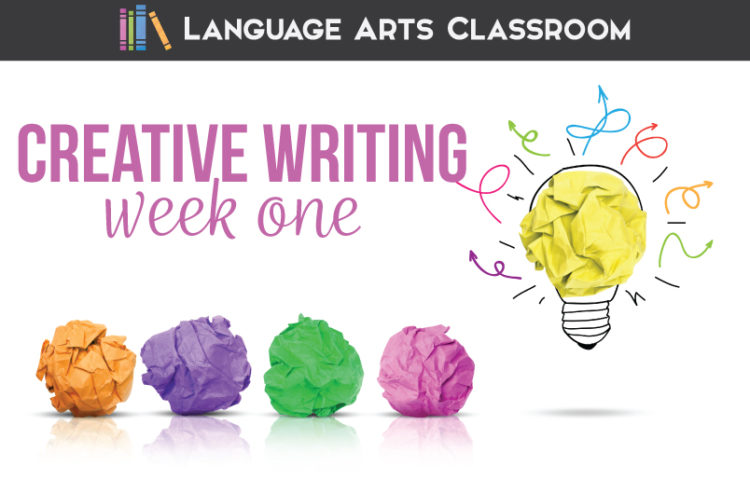
Looking for creative writing lesson plans? I am developing creative writing lesson ideas!
I’ve written and revamped my creative writing lesson plans and learned that the first week is vital in establishing a community of writers, in outlining expectations, and in working with a new class.
What are some good creative writing exercises?
Some good creative writing exercises include writing prompts, free writing, character development exercises, and fun writing games.
The first week, though, we establish trust—and then we begin powerful creative writing exercises to engage young writers and our community.
How can add encouragement in creative writing lesson plans?
I’ve found students are shy about writing creatively, about sharing pieces of themselves. A large part of the first week of class is setting the atmosphere, of showing everyone they are free to create. And! These concepts will apply to most writing lesson plans for secondary students.
Feel free to give me feedback and borrow all that you need! Below, find my detailed my day-by-day progression for creative writing lesson plans for week one.
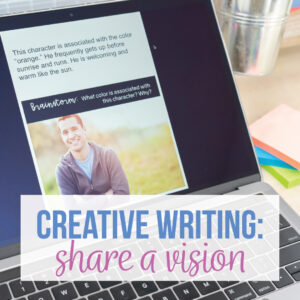
Creative Writing Lesson Day One: Sharing my vision
Comfort matters for young writers. I’m not a huge “ice breaker” type of teacher—I build relationships slowly. Still, to get student writing, we must establish that everyone is safe to explore, to write, to error.
Here are some ideas.
Tone and attitude
For day one with any lesson plan for creative writing, I think it is important to set the tone, to immediately establish what I want from my creative writing students. And that is…
them not to write for me, but for them. I don’t want them writing what they think I want them to write.
Does that make sense? Limitations hurt young writers. My overall tone and attitude toward young writers is that we will work together, create and write together, provide feedback, and invest in ourselves. Older kiddos think that they must provide teachers with the “correct” writing. In such a course, restrictions and boundaries largely go out the window.
Plus, I specifically outline what I believe they can produce in a presentation to set people at ease.
The presentation covers expectations for the class. As the teacher, I am a sort of writing coach with ideas that will not work for everyone. Writers should explore different methods and realize what works for them. First, not everyone will appreciate every type of writing—which is fine. But as a writing community, we must accept that we may not be the target audience for every piece of work.
Therefore, respect is a large component of the class. Be sure to outline what interactions you find acceptable within your classroom community.
Next, as their writing coach, I plan to provide ideas and tools for use. Their job is to decide what tools work for their creative endeavors. My overall message is uplifting and encouraging.
Finally, when we finish, I share the presentation with students so they can consult it throughout the semester. The presentation works nicely for meet-the-teacher night, too!
After covering classroom procedures and rules, I show students a TED Talk. We watch The Danger of a Single Story by Chimamanda Adichie. My goal is to show students that I don’t have a predetermined idea concerning what they should write. This discussion takes the rest of the class period.
Establishing comfort and excitement precedents my other creative writing activities. Personalize your “vision” activities for your lessons in creative writing. Honestly, doing this pre-work builds relationships with students and creates a positive classroom atmosphere.
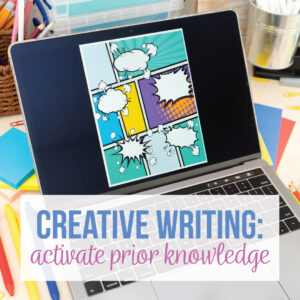
Creative Writing Lesson Day Two: Activating prior knowledge
Students possess prior knowledge concerning creative writing, but they might not consider that. Students should realize that they know what constitutes a great story. They might not realize that yet. An easy lesson plan for creative writing that will pay off later is to activate prior knowledge. Brainstorm creative, memorable, unforgettable stories with students. Share your thoughts too! You will start to build relationships with students who share the same tastes as you (and those that are completely different!).
Activation activity
During this activity, I want to see how students work together, and I want to build a rapport with students. Additionally, activating prior knowledge provides a smooth transition into other creative writing activities.
This creative writing activity is simple:
I ask students to tell me memorable stories—books, play, tv shows, movies—and I write them on the board. I add and veto as appropriate. Normally doing these classroom discussions, we dive deeper into comedies and creative nonfiction. Sometimes as we work, I ask students to research certain stories and definitions. I normally take a picture of our work so that I can build creative writing lessons from students’ interests.
This takes longer than you might think, but I like that aspect. This information can help me shape my future lessons.
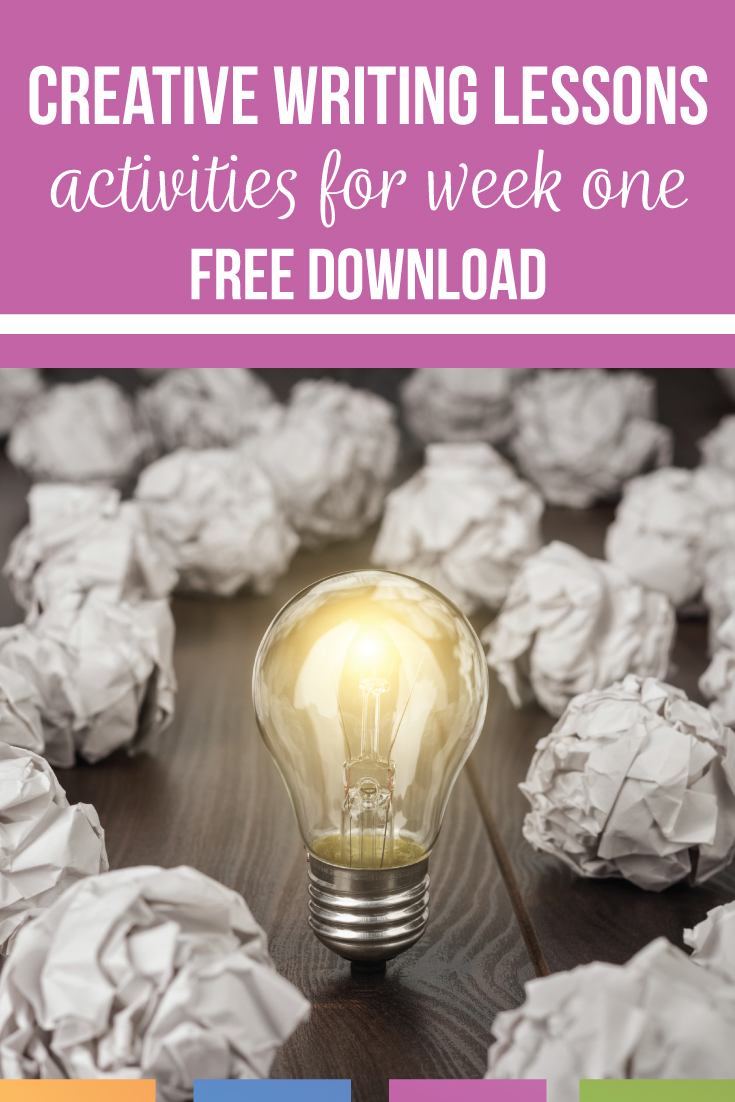
With about twenty minutes left in class, I ask students to form small groups. I want them to derive what makes these stories memorable. Since students complete group and partner activities in this class, I also watch and see how they interact.
Students often draw conclusions about what makes a story memorable:
- Realistic or true-to-life characters.
- Meaningful themes.
- Funny or sad events.
All of this information will be used later as students work on their own writing. Many times, my creative writing lessons overlap, especially concerning the feedback from young writers.
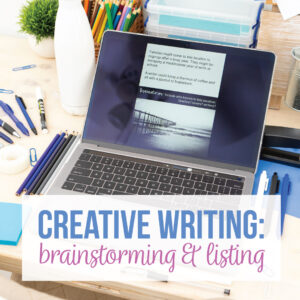
Creative Writing Lesson Day Three: Brainstorming and a graphic organizer
From building creative writing activities and implementing them, I now realize that students think they will sit and write. Ta-da! After all, this isn’t academic writing. Coaching creative writing students is part of the process.
Young writers must accept that a first draft is simply that, a first draft. Building a project requires thought and mistakes. (Any writing endeavor does, really.) Students hear ‘creative writing’ and they think… easy. Therefore, a first week lesson plan for creative writing should touch on what creativity is.
Really, creativity is everywhere. We complete a graphic organizer titled, “Where is Creativity?” Students brainstorm familiar areas that they may not realize have such pieces.
The ideas they compile stir all sorts of conversations:
- Restaurants
- Movie theaters
- Amusement parks
By completing this graphic organizer, we discuss how creativity surrounds us, how we can incorporate different pieces in our writing, and how different areas influence our processes.

Creative Writing Lesson, Days Four and Five: Creative Nonfiction
Students need practice writing, and they need to understand that they will not use every word they write. Cutting out lines is painful for them! Often, a lesson plan for creative writing involves providing time for meaningful writing.
For two days, we study and discuss creative nonfiction. Students start by reading an overview of creative nonfiction . (If you need mentor texts, that website has some as well.) When I have books available, I show the class examples of creative nonfiction.
We then continue through elements of a narrative . Classes are sometimes surprised that a narrative can be nonfiction.
The narrative writing is our first large project. As we continue, students are responsible for smaller projects as well. This keeps them writing most days.
Overall, my students and I work together during the first week of any creative writing class. I encourage them to write, and I cheer on their progress. My message to classes is that their writing has value, and an audience exists for their creations.
And that is my week one! The quick recap:
Week One Creative Writing Lesson Plans
Monday: Rules, procedures, TED Talk, discussion.
Tuesday: Prior knowledge—brainstorm the modeling of memorable stories. Draw conclusions about storytelling with anchor charts. Build community through common knowledge.
Wednesday: Graphic organizer.
Thursday and Friday: Creative nonfiction. Start narrative writing.
Students do well with this small assignment for the second week, and then we move to longer creative writing assignments . When classesexperience success with their first assignment, you can start constructive editing and revising with them as the class continues.

These creative writing activities should be easy implement and personalize for your students.
Would you like access to our free library of downloads?
Marketing Permissions
We will send you emails, but we will never sell your address.
You can change your mind at any time by clicking the unsubscribe link in the footer of any email you receive from us, or by contacting us at [email protected] . We will treat your information with respect. For more information about our privacy practices please visit our website. By clicking below, you agree that we may process your information in accordance with these terms.
We use Mailchimp as our marketing platform. By clicking below to subscribe, you acknowledge that your information will be transferred to Mailchimp for processing. Learn more about Mailchimp’s privacy practices.
Are you interested in more creative writing lesson ideas? My Facebook page has interactive educators who love to discuss creative writing for middle school and high school creative writing lesson plans. Join us!
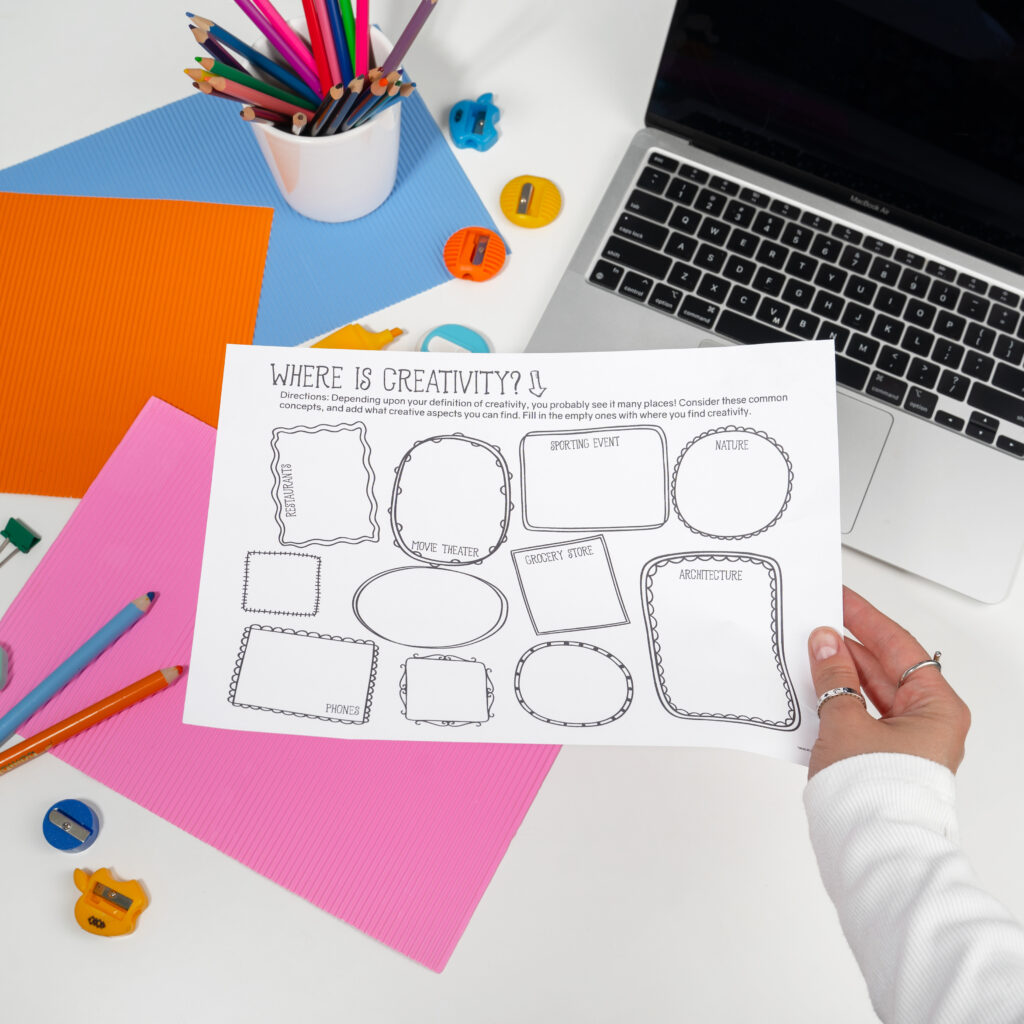
creative writing creative writing activities
Walking by the Way
the road to inspired learning
Eight Free Creative Writing Lessons
February 17, 2012 by Ami 17 Comments
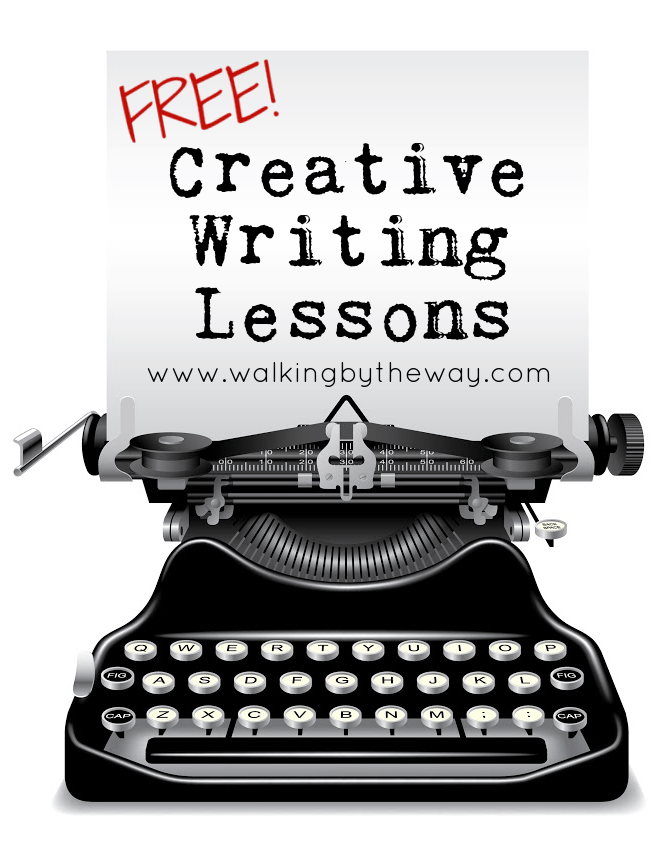
I know I throw around the word favorite all the time. But this is the truth: teaching creative writing lessons is my favorite.
I have taught creative writing enrichment for summer school students. I have taught creative writing in various homeschool settings and co-ops. I have taught big students and little students. And I love it.
Since I love to share homeschool co-op class ideas , I have compiled the creative writing lessons from a co-op class that I taught.
Creative Writing Lessons for a Homeschool Co-op Class
First, please remember that any teacher can use these creative writing lessons. You don’t need to be teaching homeschoolers. You can be a classroom teacher or a homeschool teacher at home with one student. You can even be a librarian who needs a fun program series.
Second, I used these creative writing lesson plans with upper elementary students (with maybe a few 7th graders thrown in). However, you can adapt and use them for older students or younger students!
Creative Writing Lesson Plans
Creative writing lesson one.
The first lesson focuses on cliché and metaphor. It prompts students to consider how words matter.
Grab lesson one here .
Creative Writing Lesson Two
The second lesson teaches students about sensory details: why they are important and how to include them in their writing. Students will begin using sensory details to evoke smells and sounds and sights.
Grab lesson two here.
Creative Writing Lesson Three
The third lesson introduces showing vs. telling. Students learn how to recognize authors who utilize showing, and students are able to articulate the difference between showing and telling.
Grab lesson three here.
Creative Writing Lesson Four
The fourth lesson teaches students how to capture images. We use examples of poetry and prose to discuss this important writing skill.
Grab lesson four here.
Creative Writing Lesson Five
The fifth lesson introduces the story elements of character and conflict.
Note: You may choose to split this lesson into two lessons since it covers two big elements. I only had nine weeks with my students, so I had to jam character and conflict together.
Grab lesson five here.
Creative Writing Lesson Six
The sixth lesson introduces the students to point of view and perspective. We have fun reading poems and using pictures to write descriptions from different points of view.
Grab lesson six here.
Creative Writing Lesson Seven
The seventh lesson puts everything we’ve learned together. I read the students some fractured fairy tales, and we watch some, too. Students then use the prewriting activities and their imaginations to begin drafting their own fractured fairy tales.
Grab lesson seven here.
Creative Writing Lesson Eight
The eighth lesson focuses on revision. After a mini-lesson, students partner up for peer editing.
Grab lesson eight here .
For our final class day, students bring revised work, and I host coffee shop readings. This is a memorable experience for students (and their teacher).
Creative Writing Lessons FAQ
Since posting these creative writing lessons, I have had lots of questions. I decided to compile them here in case you have the same question.
Q: What are copywork quotes? A: Copywork quotes are simply great quotes that students copy as part of their homework assignments. You can use any quotes about writing. I’ve included my favorites throughout the printable packs.
Q: Can I use this with a younger or older student? A: Absolutely! Just adapt it to meet the needs of your student.
Q: Can I use this for my library’s programming or my homeschool co-op class? A: Yes! I just ask that it not be used for profit.
Do you have any questions about teaching creative writing? What’s your biggest hang-up when it comes to teaching creative writing? I’d love to hear from you and help you solve the issue.

January 7, 2016 at 1:57 pm
Hi Theresa,
As long as you are not profitting from using them, they are yours to use! Enjoy! Wish I could be there to help facilitate all those young writers!
[…] Creative Writing Class […]
Leave a Reply Cancel reply
Your email address will not be published. Required fields are marked *
Save my name, email, and website in this browser for the next time I comment.
Creative Writing Lesson Plans: From Paragraphs to Narratives
Return from Creative Writing Lesson Plans to Creative Writing Ideas and Activities
Would you prefer to share this page with others by linking to it?
- Click on the HTML link code below.
- Copy and paste it, adding a note of your own, into your blog, a Web page, forums, a blog comment, your Facebook account, or anywhere that someone would find this page valuable.
Helping You Write Across the Curriculum!
copyright 2009-2013 www.creative-writing-ideas-and-activities.com
- Writing Topics
- Writing Prompts
- Writing Ideas
- Writing Activities
- Lesson Plans
- Writing Tips
- Privacy Policy
Our Most Popular Pages
1. Teaching Resources
2. How to Write a Myth
3. February Writing Prompts
4. How to Write a Legend
5. Writing a Personal Narritive
6. Writing Fables
7. Writing Mystery Stories
8. Math Prompts
9. Science Writing Prompts
10. Elements of Persuasive Writing
Recommeded Resources:
AnyWord(TM) Spelling Practice Series!
Worksheets, games and activities to use with any spelling words. Three volumes in all!
Download yours today!
Stop Essay Pain!
LitWorks.com
Resources to help students prepare for literature examinations.
Teach Kids Drama!
Creative Writing Lesson Plans
Keep your class engaged with our creative writing lesson plans! Discover interactive lessons that encourage imagination and self-expression, crucial skills for effective writing. Help students write stories, poems, thank-you notes, and more such creative stuff! With clear learning objectives, fun writin ... Read more g prompts, and simple instructions, our creative writing lesson plans offer exceptional guidance to language arts teachers. Ready to build confident writers in your classroom? Start now for free!

CONTENT TYPE
- Lesson Plans
- Number Sense (24)
- Counting (9)
- Compare and Order Numbers (13)
- Place Value (9)
- Addition (42)
- Subtraction (28)
- Multiplication (29)
- Times Tables (8)
- Division (11)
- Fractions (25)
- Fractions Operations (17)
- Decimals (9)
- Geometry (5)
- Measurement (8)
- Counting Money (5)
- Algebra (6)
- Word Problems (36)
- Reading (160)
- Phonics (44)
- Books and Genres (4)
- Reading Skills (101)
- Communication Skills (13)
- Writing (10)
- Creative Writing (9)
- Grammar (93)
- Adverbs and Adjectives (15)
- Nouns and Pronouns (21)
- Prepositions and Conjunctions (12)
- Punctuation (15)
- Sentences (10)
- Verbs and Tenses (20)
- Vocabulary (22)
- Affixes (5)
- Making Connections in Reading (5)

Gratitude & Grammar Lesson Plan
Learn grammar with a twist of gratitude in this engaging lesson.

Magic of Grammar Lesson Plan
A festive journey through the world of grammar using holiday-themed activities.

Rhyme Time Rendezvous Poetry Lesson Plan
An engaging lesson plan focusing on rhymes, syllables, and poetry appreciation.

Book Builders: How-To Writing Lesson Plan
Learn to write a how-to book in this interactive lesson!

Invitation Innovation Lesson Plan
Learn to design an engaging birthday invitation in this interactive lesson.

Poetry Club Sparkle: An Interactive Learning Experience Lesson Plan
Explore the magic of poetry with our interactive lesson plan.

Poetry Playground Rhythm & Rhyme Lesson Plan
Explore the magic of poetry in this interactive lesson!

Rhythm Revelations Poetry Lesson Plan
An engaging lesson plan that explores the rhythm of poetry through singing.

Magic Wand Mystery: An Interactive Storytelling Workshop Lesson Plan
Engage in an interactive storytelling workshop with activities like narration building and rebus story.
Your one stop solution for all grade learning needs.
- Varsity Tutors
- K-5 Subjects
- Study Skills
- All AP Subjects
- AP Calculus
- AP Chemistry
- AP Computer Science
- AP Human Geography
- AP Macroeconomics
- AP Microeconomics
- AP Statistics
- AP US History
- AP World History
- All Business
- Business Calculus
- Microsoft Excel
- Supply Chain Management
- All Humanities
- Essay Editing
- All Languages
- Mandarin Chinese
- Portuguese Chinese
- Sign Language
- All Learning Differences
- Learning Disabilities
- Special Education
- College Math
- Common Core Math
- Elementary School Math
- High School Math
- Middle School Math
- Pre-Calculus
- Trigonometry
- All Science
- Organic Chemistry
- Physical Chemistry
- All Engineering
- Chemical Engineering
- Civil Engineering
- Computer Science
- Electrical Engineering
- Industrial Engineering
- Materials Science & Engineering
- Mechanical Engineering
- Thermodynamics
- Biostatistics
- College Essays
- High School
- College & Adult
- 1-on-1 Private Tutoring
- Online Tutoring
- Instant Tutoring
- Pricing Info
- All AP Exams
- ACT Tutoring
- ACT Reading
- ACT Science
- ACT Writing
- SAT Tutoring
- SAT Reading
- SAT Writing
- GRE Tutoring
- NCLEX Tutoring
- Real Estate License
- And more...
- StarCourses
- Beginners Coding
- Early Childhood
- For Schools Overview
- High-Dosage Tutoring
- Free 24/7 Tutoring & Classes
- Live Learning Platform
- Learning Outcomes
- About The Tutors
- Talk with Our Team
- Reviews & Testimonials
- Press & Media Coverage
- Tutor/Instructor Jobs
- Corporate Solutions
- About Nerdy
- Become a Tutor

- Book Reports
- Children’s Literature
- Interdisciplinary
- Just for Fun
- Literature (Prose)
- Professional Resources
- Reading/Literacy
- Shakespeare
- Study Guides
- Technology Integration
- Young Adult Literature
Creative Writing
15 Classified Ads We Hope Had Happy Endings Writing prompt: choose one of these historical ads and construct a narrative that supports it. Include characters, location, and other necessary details. (Teachers may wish to check the ads for appropriateness.)
20 Mystical Bridges That Will Take You To Another World Creative writing prompt: "I walked across the bridge and ..." The photographs of real bridges on this page are astonishingly beautiful. However, the page also carries ads that may not be appropriate for the classroom. Consider copying the photographs into a new file for classroom use.
27 Magical Paths Begging To Be Walked Photographs of beautiful paths all over the world, showing a variety of seasons and geography, just waiting to inspire a poem or serve as the setting for a short story. Note: this page carries ads that may not be appropriate for the classroom. Consider copying the photographs into a new file for classroom use.
The 100-Word Challenge In this activity students respond to a prompt using not more than 100 words. Writing is posted on a class blog, where responses are invited. The activity encourages regular writing for an authentic audience. It's designed for students 16 and under.
Adding Emotions to your Story A good lesson on adding detail, "exploding" an incident, and "show, don't tell." It includes handouts and is designed for grades 3-5.
After the First Draft: 30 Fast, Easy Writing Tips for the Second Draft This 37-page document is designed for writers of novels, but many of the tips apply equally to writers of short stories. Clear, simple, and easy to read, appropriate for 5th or 6th grade (in places) and up. Adobe Reader required for access.
All Together Now: Collaborations in Poetry Writing Students write a line of poetry in response to something the teacher reads. Their lines, together, form a poem. This unit is designed for grades K-2.
Bernadette Mayer's List of Journal Ideas A list of journal topics that will work on multiple grade levels. Scroll down for a list of "Writing Experiments" that will work well in a creative writing unit.
The Book of Butterflies by Michael Leunig (Scroll down on the page.) This short (1:06) video explores the question "What happens when a book comes to life?" It will work well on almost any grade level.
By the Old Mill Stream A creative writing prompt, differentiated for elementary and middle and high school students. Students begin writing a narrative. In the second part of the prompt, they write a description.
Calling on the Muse: Exercises to Unlock the Poet Within From Education World.
Can You Haiku? from EdSitement Complete lesson plans for writing haiku, links to additional material.
Character Name Generator Choose ethnicity, decade of birth, and gender, and this site will generate an appropriate name and a possible character description.
Characterization in Literature and Theater Students explore various methods authors use to create effective characters. Students will consider what makes a character believable and create their own characterizations. They will also write a short script using the characters they created and act out the script.
The Clues to a Great Story One-page handout with 5 essential elements for good storytelling. Uses "The Ugly Duckling" and more contemporary stories for examples.
The Color of Love In this lesson students will be invited to reflect on a variety of colors and the pleasurable things that those colors invoke. They then will write a poem about someone they love following Barbara Joosse's style in I Love You the Purplest .
Creating Characters Students examine character as a significant element of fiction. They learn several methods of characterization, identify and critique these methods in well-known works of fiction, and use the methods in works of their own. Students also identify, examine, evaluate, and use the elements dialogue and point of view as methods of characterization.
Creative State of Mind: Focusing on the Writing Process In this lesson, students examine the lyrics of rap artist Jay-Z for literary elements including rhyme, metaphor, puns and allusions, then consider what he says about his own writing process. Finally, they analyze additional lyrics and apply lessons from Jay-Z's process to their own reading and writing.
The Cutting Edge: Exploring How Editing Affects an Author's Work Students examine the writing of short-story author Raymond Carver as well as their own writing to explore how editing can affect the text, content and context of an author's work.
Save 10% today on your lessons using the code GIVEME10

Creative Writing Lesson Plans

Creative writing is an important writing style for students to learn about and experience on their journey to becoming writers. Helping students embrace their creativity is a great way to get students writing. Students enjoy writing more when they get choice over their topic and format. Read more about how I use the RAFT writing model in the blog post Student Engagement Through Choice Writing .
Creative writing can be used weekly during free choice writing time, as a stand-alone unit or left for those days when you have a substitute teacher and want to leave an engaging lesson for your students.
Check out the creative writing lessons below to help infuse excitement into your writing program.

Year-Long Creative Writing Choice Boards
This no prep – just photocopy and teach, Creative Writing Full Year Bundle will keep your students engaged in their writing. This bundle provides holiday writing prompts (Halloween, Christmas, Valentine’s Day, Easter) as well as seasonal writing prompts (Fall, Winter, Spring, Summer, Back to School) to support an inclusive classroom environment.
Students will select one of the provided seasonal or holiday-themed character roles and create a written or visual product based on the character’s specific writing prompt using the RAFT (Role, Audience, Format, Topic) format.
Find the Creative Writing Full Year Bundle on Shopify CAD or Teachers Pay Teachers USD .
Included in this Resource:
- Detailed Teacher Instructions
- 9 Different Creative Writing Assignments (with multiple background options)
- Standards-Based Grading Rubric (Level 1 – Level 4)
- Points-Based Grading Rubric (Provides a final percentage mark)
- Google Classroom-ready PDFs

Creative Writing Prompts and Activities
Get your students excited about writing with these no-prep creative writing prompts. Students will select their topic from 20 different writing prompts.
These prompts can be used as a stand-alone assignment, sub plans, or enrichment task. Integrate these prompts into your Writer’s Workshop classes or any ELA writing lesson. Find the Creative Writing Prompts and Activities on Shopify CAD or Teachers Pay Teachers USD .
Resource Includes:
- Teacher Instructions
- Student Assignment Sheet (List or Choice Board Format)
- 6 Anchor Charts
- 20 different levelled writing prompts
- 2 Rubric Options (Standards-Based Rubric or Points-Based Rubric)
Interactive Writing Prompts
These no-prep interactive writing prompts get students up and moving during English class. Students use the 9 different story prompts to get thinking creatively about what might happen in each scenario. Students must move around the classroom to answer each other’s story writing prompts. Find the Interactive Writing Prompts on Shopify CAD or Teachers Pay Teachers USD .
- 9 Different Open Ended Story Prompts
- 1 Blackline Master for students to create their own
Are you looking for more writing activities?
- Argumentative Essay Writing Unit
- My Life in Logos Paragraph Writing Assignment
- Media Literacy Review Writing 16 Lessons
- Pet Memes Narrative Writing Assignment
- Persuasive Writing Assignment Michael vs LeBron
Related Posts

This FREE persuasive writing unit is
- Perfect for engaging students in public speaking and persuasive writing
- Time and energy saving
- Ideal for in-person or online learning
By using highly-engaging rants, your students won’t even realize you’ve channeled their daily rants and complaints into high-quality, writing!

Trending Post : 12 Powerful Discussion Strategies to Engage Students

10 Simple Ways to Add Creativity to ELA Lessons
You’re on a mission to add creativity to your lesson plans in order to engage students in meaningful learning. Excellent! Your students will thank you.
When we think about making lesson plans creative, it’s important to maintain the integrity of challenging students in ways that are developmentally appropriate. Creativity doesn’t equal fluff. Likewise, it shouldn’t mean we are stressing ourselves out to reinvent the wheel.
This week, I’ve gathered a handful of my friends to create a list of practical ways we can add spice to a middle or high school English lesson plan. The goal? Cover standards and captivate students – practically.
Let’s take a look at some possibilities.

1. Differentiate the Learning
Breathe life and personalization into vocabulary instruction by changing up the way you ask students to think about their words. Doodling, associations, games, and challenges make vocabulary memorable. Brain-based, differentiated vocabulary lessons have deepened my students’ appreciation for words as well as brought movement to the classroom. Plus, it works! Students remember the words. Try a lesson for free here .

2. Use QR Codes
Lesson plans aren’t the only thing you can add creativity to in the classroom. My friend Amanda from Mud and Ink teaching wrote a whole post about how she uses QR codes to transform her classroom management. It’s brilliant, and it got me thinking. Adding QR codes to a simple lesson plan is just one more way we can engage students with technology. For instance, I use them with vocabulary !
3. Make it a Manipulative
Creativity does not mean diminished learning, especially with grammar. My friend Lauralee from Language Arts Classroom says we should let students hold their language – and manipulate it, like this . Students benefit from being able to arrange language. It helps them see how they, as writers, can use words to craft powerful sentences.
4. Spice up Discussions
Let’s face it. Some class discussions are boring. Students aren’t always interested enough to participate, and everyone walks away feeling less than inspired. Ashley from Building Book Love wrote a post detailing her favorite strategies to engage students during Socratic Seminars. Read about how you can use Flipgrid, socratic soccer balls, emoji stems, silent discussion opportunities, the 3-2-1 strategy, and BINGO to add creativity to your discussions here .
5. Pair Unusual Texts
Are students tired of nonfiction articles? Try blending high-interest informational texts with poetry by asking students to write creative and symbolic pieces that blur the lines between verse and prose, like this . Or, add short films to poetry to create a unique experience with analyzing paired texts. Here are some film and poem pairing suggestions.
6. Play Chef
Project-based learning is a creative way to engage students in meaningful learning. Any time we can add food into the mix, students get excited. Try this free culinary symbolism project from Ashley at Building Book Love next time you want students to analyze literature. Want to take it further? Treat your students to a snack as they hone their literary cooking and baking skills.
7. Stage a Mock Trial
Citing textual evidence is an essential ELA skill, but it doesn’t have to be boring. A mock trial is a creative, engaging, and authentic way to practice this skill and many others, including close reading, persuasion and argument, writing, and speaking and listening. Mock trials usually work for any text with a death, crime, or moral debate (so, just about all literature, right?!).
If you’d like more information on how to set up your own mock trial, check out this blog post by Abby from Write on with Miss G. And, if you want ready-to-go resources, rubrics, instructions, and absolutely everything you need to facilitate a mock trial, this is a bundle that works for ANY text.
8. Add some Color
Coloring in the classroom has brain benefits for older students. Since many students struggle with grammar, Lauralee from Language Arts Classroom created Color by Grammar . Coloring is relaxing, it helps students refocus, and it increases creative thought. Adding a splash of coloring to any type of lesson can be beneficial. Read more about the research behind this approach here .
9. Try an Escape Room
When we finish teaching a novel or play, traditionally, we roll right into the assessment. To add a little bit of creativity to the same old routine of ending a story, try creating an escape room . There are tons of resources online to help you get started, or, if you happen to be reading A Raisin in the Sun , Amanda from Mud and Ink Teaching has one made for you. Here’s how it works:
- The Place: Chicago PD Headquarters.
- The Scandal: Willy Harris has run off with Walter’s money.
- The Task: Student detectives must use clues, close reading strategies and teamwork to track down Willy Harris before the bell rings.
10. Just Add Music
Music is my go-to when I need to add a little bit of pizzazz and creativity to an otherwise straight forward lesson plan. I use music with poetry, as a hook for a lesson plan on figurative language, as a paired text complement, and as an end-of-the-year reflection, among other things. Try asking students to make a playlist of their year or let them analyze song lyrics during your next poetry or analysis unit. Download this song activity for free!
Hopefully you’ve found some inspiration that will help you add creativity to your lesson plans. Keep your class fresh and engaging for older students by surprising them with something new – a brain-based learning approach, a lesson on symbolism, some QR codes, or an enticing discussion strategy. Playing with creativity can ward off boredom and burnout – for both teachers and students.
Looking for more creative teaching ideas? Check out these posts.
Creative Approaches for Teaching Vocabulary
Engaging lesson plans for any time of year, using the one pager as a creative response to reading, a creative music lesson plan for the end of the year, assessing comprehension without making students hate reading, get the latest in your inbox.
- Share full article
Advertisement
Supported by
Nine Teaching Ideas for Using Music to Inspire Student Writing

By Natalie Proulx
- May 10, 2018
Some of the greatest written works of our time have been inspired by music. Walt Whitman conceived of and wrote “Leaves of Grass” while listening to opera . Alice Walker, Langston Hughes, Ntozake Shange and Ralph Ellison were all moved by spirituals, jazz and blues . And Lin-Manuel Miranda’s rap musical “Hamilton” was born of his love of hip-hop . These writers understood what many educational researchers know — that music opens up pathways to creative thinking, sharpens our ability to listen and helps us weave together disparate ideas .
In this teaching resource, we suggest nine exercises to use music to inspire student writing — from creating annotated playlists and critical reviews to music-inspired poetry and personal narratives. Each idea pulls from Times reporting, Opinion pieces and multimedia on music to give students a place to start. The activities are categorized according to three genres: creative and narrative writing; informative and explanatory writing; and persuasive and argumentative writing.
How do you use music in your classroom? Let us know in the comments.
Creative and Narrative Writing
Exercise #1: Write a story or poem inspired by music.
One way you might let your students be inspired by music is to have them describe in words what they hear, a method Jean-Michel Basquiat employed in his poetry and paintings.
In “ Bowie, Bach and Bebop: How Music Powered Basquiat ,” Ekow Eshun writes:
In 1979, at 19, the artist Jean-Michel Basquiat moved into an abandoned apartment on East 12th Street in Manhattan with his girlfriend at the time, Alexis Adler. The home, a sixth-floor walk-up, was run-down and sparsely furnished. Basquiat, broke and unable to afford canvases, painted with abandon on the walls and floor, even on Ms. Adler’s clothes. The one item that remained undisturbed was Ms. Adler’s stereo, which had pride of place on a shelf scavenged from the street. “The main thing for us was having big speakers and a blasting stereo. That was the only furniture I purchased myself,” said Ms. Adler, who still lives in the apartment. When Basquiat was around, she recalled, “music was playing all the time.” On Thursday, the exhibition “Basquiat: Boom for Real” opened at the Barbican Center in London. The show focuses on the artist’s relationship to music, text, film and television. But it is jazz — the musical style that made up the bulk of Basquiat’s huge record collection — that looms largest as a source of personal inspiration to him and as a subject matter.
Invite your students to read the article and then listen to the Times-curated Spotify playlist “ The eclectic taste of Jean-Michel Basquiat ” as they view his art and read his poetry . Discuss what they notice about the musical influence in Basquiat’s work. How do the content, colors, textures and shapes in his paintings resemble the sounds they hear? How are these reflected in the words, phrases, mood and rhythm of his poems?
Next, have students listen to a song or playlist (perhaps one they created, one you created or one of these Times-curated ones) and, like Basquiat, let them write what they hear:
• describe the images that come to mind; • name the feelings and thoughts triggered by the imagery and sounds in the music; • mimic the pacing and rhythm through word choice, sentence structure and line breaks; • borrow the words, phrases or lines that resonate most; • or build on a theme or message.
Here’s an example of what one composer wrote as he listened to his own classical piece, “Become Desert”:
From the stillness around you a high glassy sound descends, like first light. Each new sound seems to breathe — emerging from and receding back into the stillness — and the glint of bells, like desert plants, here and there. Almost imperceptibly the music swells and continues falling in pitch. From somewhere above — like a gleam of metal, like sunlight emerging from behind a ridgeline — comes the sound of flutes. You are in a strange landscape. You don’t know how to read the weather or the light. You are unsure how long you will be here, or how challenging the journey may be.
To take this exercise a step further, students might use what they wrote while listening to music to develop a short story or poem. They might share their writing and song choices with the class so their classmates can analyze how music inspired their writing.
Exercise #2: Pen your own song or rap.
Invite students to write their own music about topics, events or themes you are studying in class. How can they summarize in song the role of the mitochondria , the main themes of “Romeo and Juliet” or the events that led to the Civil War?
Here’s an example from Julien Turner , 20, who produced this music video called “ XY Cell Life ” for a college biology class:
For inspiration, students might check out the Times “ Diary of a Song ” video series to see how songwriters and musicians like Zedd , Ed Sheeran and Justin Bieber make hits. What stands out to them about these songs? What are the artists’ processes for making music? How do they write lyrics and sounds that resonate with an audience? How do they communicate content and emotion?
You might have students simply write lyrics — like these students who wrote “Hamilton” hip-hop verses and these young people who summed up the year’s news in our annual “Year in Rap” challenge .
Or, invite them to make their own music videos or recorded songs. In this case, you might refer to use our lesson plan “ Project Audio: Teaching Students How to Produce Their Own Podcasts ,” which has a helpful section on audio editing and advice for gathering non copyrighted sound effects and music.
Exercise #3: Share what music means to you.
What role does music play in your students’ lives?
What are they listening to right now? What musicians and bands mean the most to them? What music inspires them? What song lyrics do they consider literature? Which artists do they believe are the future? Which do they think will stand the test of time?
We have published over 1,000 writing prompts for students , including many, like the questions above, dedicated to personal and narrative writing about music. You might have your students choose a question that speaks to them and read the related Times article. Then invite them to share their thoughts, stories, opinions and experiences in writing.
You can search “music” to find our newest music-related writing prompts here , which are open for comment indefinitely.
Informative and Explanatory Writing
Exercise #4: Connect songs to current events.
Music has always been a reflection of and window into society, culture and history — and the current era is no different. Hip-hop, folk, classical and even opera music draw on current events and politics for source material.
What connections can your students make between the music they listen to and current events? How does learning more about the context in which a song was written help them better understand it?
You might start by having students read and analyze how journalists make connections between music and current events every day. Take Childish Gamino’s latest video, “ This Is America ,” for instance. In a roundup of the best writing about this music video, Judy Berman writes:
But Glover’s graceful moves aren’t exactly the point. There’s plenty of messaging about race, violence and the entertainment industry in the song and video — which helps explain why fans and critics have devoted so much time to dissecting its references and debating its meaning.
And Doreen St. Félix from The New Yorker relates the video to the present day:
The video has already been rapturously described as a powerful rally cry against gun violence, a powerful portrait of black-American existentialism, a powerful indictment of a culture that circulates videos of black children dying as easily as it does videos of black children dancing in parking lots.
You might have students read the roundup or one of the articles it excerpts, or let them choose another topic or genre that interests them, such as:
Beethoven’s 200-Year-Old ‘Fidelio’ Enters Today’s Prisons Mouse on Mars at M.I.T.: A Symposium Becomes a Dance Party Eminem Lashes Out at Trump in Freestyle Rap Video New ‘Hamilton Mixtape’ Video Takes Aim at Immigration Celebrating Women’s Rights, ‘That Most American of Operas’ Watch 5 Moments When Classical Music Met Politics Can North Korea Handle a K-Pop Invasion? Review: Beyoncé Is Bigger Than Coachella
For whichever article they choose, students should consider: What current events does the music they read about reference? How do these allusions contribute to the artist’s message? What other themes in the music can they relate to what is happening in the world?
Then, challenge students to pair a song of their choosing with one or more Times articles and write an essay that explains the relationship between the song and the current or historical events.
Students might start by annotating song lyrics themselves or referring to Genius to find explicit connections and discover underlying themes that in some way relate to society, culture, history and politics. Students may also choose to research the artist to find out more about his or her background, beliefs and politics.
For help in writing the essay, what we call a text-to-text pairing , we also have a whole lesson plan that guides classes through the process of generating and writing about relevant connections between their studies and the world today, as well as dozens of example essays written by teenagers .
Exercise #5: Create an annotated playlist of songs related to a topic.
Every Friday, The Times publishes “ The Playlist ,” a weekly tour of notable new music and videos. Times pop music critics choose about a dozen of the week’s most popular or intriguing songs and music videos and write a short commentary for each. They even create a Spotify playlist of the songs each week.
You can use “The Playlist” as a model for students to compile their own annotated playlists — playlists with explanatory text or commentary for each song — related to a topic you are studying in class. It might be straightforward, such as songs that reference historical or current events, use a particular literary device or exhibit a specific musical technique. Or, the playlist could be more symbolic, like pieces that tell a story when played together, demonstrate a theme from a novel or capture the essence of a time period or setting. (You might use one of these as an example of a theme-oriented playlist.) Playlists could even be autobiographical, with students selecting songs that express aspects of their own identities.
Students can read through several of the past columns and listen to the playlists to determine what makes for compelling commentary. For example, on Billie Eilish’s and Khalid’s “Lovely,” Jon Pareles writes:
“Lovely” is the song of someone inextricably attached or trapped: “I hope someday I’ll make it out of here,” Billie Eilish sings with Khalid — not in dialogue or counterpoint, but in unison, as if they’re each others’ partner and burden. “Wanna feel alive outside/I can fight my fear.” The backdrop is piano and strings lingering on two chords; the melancholy never lifts, and at the end Khalid and Ms. Eilish share a chilling greeting: “Hello-welcome home.” J.P.
And on First Aid Kit’s “Fireworks,” Mr. Pareles writes:
First Aid Kit, a duo of sisters from Sweden who usually favor a folky, countryish approach — they’ve got a song named “Emmylou,” after Ms. Harris — turn to a gauzy retro sound in “Fireworks,” a song always about ending up lonely: “Why do I do this to myself every time/I know the way it ends even before it’s begun.” With a 1950s slow-dance beat and echoey guitars, it’s already nostalgic for the next failed romance. J.P.
Ask students: What do they notice about h ow the commentary is written? What does the writer include and why? How is it organized? What makes it interesting (or not)?
After students have curated their own playlists, they are ready to write song annotations. Some ingredients they should include in their writing are: a claim explaining how the song relates to the topic or theme; evidence from the song (e.g., lyrics, instruments, rhythm or melodies) illustrating their claim; and analysis that explains the significance of these aspects of the song.
Students can share their final playlists on Spotify so that everyone in the class can listen to and comment on them.
Exercise #6: Profile an artist in an imagined interview.
The Times Music section regularly profiles artists from different genres, time periods and corners of the globe. Students can use these articles and interviews as mentor texts before doing research and writing their own mini-biographies of a music figure they admire.
In an “imagined interview,” students, working individually or in pairs, play the part of both interviewer and interviewee. They do background research on an artist they select, come up with a list of questions and answers for the interview, and then write a profile on their subject.
To start, have students read one of these interviews with musicians:
Khalid, the Teenager With 5 Grammy Nominations: ‘They Got It Right This Year’ Jay-Z and Dean Baquet, in Conversation John Mayer Has More to Say: The Outtakes Bruce Springsteen on Broadway: The Boss on His ‘First Real Job’ Adele on ‘25’: Song by Song In Hip-Hop, Inspiration Arrived by Way of Kirk Franklin Gwen Stefani on Spirituality, Insecurity, Pharrell and ‘Truth’
Ask students: What types of questions did the interviewer ask? What subjects did the two discuss? What questions were missing from the interview that you wish were asked?
If you plan on having students write narratives based on their imagined interviews, they should also read at least one example of how Times writers write narratives based on interviews. Here are a few:
The 5 ‘Handsome Girls’ Trying to Be China’s Biggest Boy Band ‘I Could Barely Sing a High C’: Pretty Yende Finally Conquers Lucia For Milford Graves, Jazz Innovation Is Only Part of the Alchemy Dua Lipa Was Raised on Pop Bangers. Now She Writes Them. Valee, Kanye West’s New Signee, Is a Rapper Who Just Might Build You a Koi Pond Rafiq Bhatia Is Writing His Own Musical Language Ashley McBryde Takes Nashville, No Gimmicks Required
While reading, they should consider the following: What information did the reporter include and why do you think they made these choices? How did they effectively weave in biographical details to tell a story about the artist and the music?
Next, assign students to choose their own musical artist to interview and profile. The following steps can guide students through the process:
1. Do Your Research : To learn more about the artist you selected to interview, do an in-depth study of several song lyrics or an album, read published interviews with the artist, watch a video or listen to radio interviews to see how the artist speaks.
2. Prepare Your Questions : Consider this artist’s particular music and biography. What more do you want to know about the artist and his or her music? What in the songs or videos you studied struck you that you would like to ask about? For more inspiration, our lesson plan “ Beyond Question: Learning the Art of the Interview ” provides additional advice on how to conduct good interviews.
3. Conduct Your Imagined Interview : Based on your research of artists — their background, their music and the way they speak — imagine how they might respond to your questions. Be creative, but try to stay true to who the artist is. Alternatively, you could role-play the interview in partners, where one person is the interviewer and the other is the artist. It might be helpful to record the interview and take notes.
4. Write Your Article : You may choose to write your interview in a question and answer format , or create a narrative .
5. Share the Final Product : Share your imagined interviews with your classmates and reflect on the activity. Was your writing convincing to readers? What did you learn about writing artist profiles?
Persuasive and Argumentative Writing
Exercise #7: Review an artist, album or song.
Which artists, albums and songs can your students not stop talking about — either because they love them or hate them? Channel that energy into an argumentative essay using our culture review-writing lesson plan . In this lesson, students read Times reviews and heed advice from Times critics to write their own. They practice developing a clear claim, citing evidence and writing with a strong voice.
You might allow students to choose one of their favorite (or least favorite) artists or songs to practice writing passionately and knowledgeably about a subject. Or, challenge them to explore a genre of music they might not normally listen to and see what they can learn.
Consider having your students submit their finished pieces to our annual student review contest . They can read winning reviews from past years here .
Exercise #8: Weigh in on the latest criticisms, trends and news in music.
Music today incites opinions not just about the artists and albums themselves, but also about universal themes, like the music industry , social media , morality , the human condition , culture , the past and the future. “ Popcast ” is The Times’s podcast dedicated to discussing these very criticisms, trends and news in music.
You can invite students to weigh in on the music-related topics they care about most in a group writing activity that mimics the conversational style of this podcast. Here, they learn how to make a claim, develop it with evidence, write counterclaims and respond directly to one another in an informal and fun way.
First, you might start by having students listen to one full episode or excerpts from “ Popcast ” to analyze how the discussion unfolds. What background information is provided? How do the critics talk to and respond to one another? How do they open and close each episode?
Beyoncé and Kendrick Lamar Break Boundaries
Or, you might have students examine what a conversation like this looks like in writing. “ Kendrick Lamar Shakes Up the Pulitzer Game: Let’s Discuss ” by Times music editors provides a good example. The conversation begins:
JON PARELES To me, this prize is as overdue as it was unexpected. When I look at the Pulitzers across the board, what I overwhelmingly see rewarded are journalistic virtues: fact-gathering, vivid detail, storytelling, topicality, verbal dexterity and, often, real-world impact after publication. It’s an award for hard-won persuasiveness. Well hello, hip-hop. ZACHARY WOOLFE … But there is also wariness, which I join, about an opening of the prize — not to hip-hop, per se, but to music that has achieved blockbuster commercial success. This is now officially one fewer guaranteed platform — which, yes, should be open to many genres — for noncommercial work, which scrapes by on grants, fellowships, commissions and, yes, awards. PARELES That response is similar to many publishing-world reactions when Bob Dylan got the Nobel Prize in Literature — that a promotional opportunity was being lost for something worthy but more obscure, preferably between hard covers. A literary figure who had changed the way an entire generation looked at words and ideas was supposed to forgo the award because, well, he’d reached too many people? Do we really want to put a sales ceiling on what should get an award? The New York Times and The New Yorker already have a lot of subscribers … uh-oh.
Then, in small groups, have students come up with their own music topics worthy of debate. For inspiration, they might browse some of the past “Popcast” episodes.
You might then have them brainstorm some initial ideas and conduct research in the Times Music section to deepen and broaden their knowledge about the subject.
Next, invite them into a written conversation about their chosen topic. One student initiates the conversation and then each person in the group takes a turn responding to what each other writes — acknowledging their classmates’ remarks, voicing their own opinions, making connections and citing evidence to support or disagree with others.
Exercise #9: Write an editorial on a music-related topic.
Many musicians and music aficionados also contribute Opinion pieces to The Times, where they write passionately and persuasively about music’s influence in their lives, culture and society.
What music-related topics do your students care about? Do they believe music should be a required subject in school? What do they think today’s artists say about the world they live in? Can and should musicians’ work be separated from their personal lives?
Have your students write an editorial on a music-related topic that matters to them. We’ve written several lesson plans on teaching argumentative writing, including “ For the Sake of Argument: Writing Persuasively to Craft Short, Evidence-Based Editorials ,” “ I Don’t Think So: Writing Effective Counterarguments ” and “ 10 Ways to Teach Argument-Writing With The New York Times .”
You can pair any one of these lessons with music editorials as mentor texts, like the ones below:
A Note to the Classically Insecure The Real Song of the Summer Three Cheers for Cultural Appropriation The Heartbreak of Kanye West Is Music the Key to Success? Graceland, at Last The Songs That Bind
Students can also search for their own examples in the Music or Opinion sections. Or, refer to the many music-themed argumentative writing prompts we have published.
They might consider entering their finished editorials into our annual student editorial contest . And they can read essays from past winners here .
Other Music-Related Resources from The Learning Network
Lesson Plan | The Ten-Dollar Founding Father Without a Father: Teaching and Learning With ‘Hamilton’
Lesson Plan | Teaching With Protest Music
Teaching Close Reading and Compelling Writing With the ‘New Sentences’ Column
- International
- Schools directory
- Resources Jobs Schools directory News Search

Outstanding lesson: plan and resources based on creative writing techniques for Year Four.
Subject: English
Age range: 7-11
Resource type: Lesson (complete)
Last updated
7 March 2017
- Share through email
- Share through twitter
- Share through linkedin
- Share through facebook
- Share through pinterest

Creative Commons "Sharealike"
Your rating is required to reflect your happiness.
It's good to leave some feedback.
Something went wrong, please try again later.
nadegemartin
Empty reply does not make any sense for the end user
Good differentiation
lisaholly01
Report this resource to let us know if it violates our terms and conditions. Our customer service team will review your report and will be in touch.
Not quite what you were looking for? Search by keyword to find the right resource:
- Try for free
7th Grade Creative Writing Lesson Plans
- Most Popular
- Most Recent

Purdue Online Writing Lab Purdue OWL® College of Liberal Arts
Welcome to the Purdue Online Writing Lab

Welcome to the Purdue OWL
This page is brought to you by the OWL at Purdue University. When printing this page, you must include the entire legal notice.
Copyright ©1995-2018 by The Writing Lab & The OWL at Purdue and Purdue University. All rights reserved. This material may not be published, reproduced, broadcast, rewritten, or redistributed without permission. Use of this site constitutes acceptance of our terms and conditions of fair use.
The Online Writing Lab at Purdue University houses writing resources and instructional material, and we provide these as a free service of the Writing Lab at Purdue. Students, members of the community, and users worldwide will find information to assist with many writing projects. Teachers and trainers may use this material for in-class and out-of-class instruction.
The Purdue On-Campus Writing Lab and Purdue Online Writing Lab assist clients in their development as writers—no matter what their skill level—with on-campus consultations, online participation, and community engagement. The Purdue Writing Lab serves the Purdue, West Lafayette, campus and coordinates with local literacy initiatives. The Purdue OWL offers global support through online reference materials and services.
A Message From the Assistant Director of Content Development
The Purdue OWL® is committed to supporting students, instructors, and writers by offering a wide range of resources that are developed and revised with them in mind. To do this, the OWL team is always exploring possibilties for a better design, allowing accessibility and user experience to guide our process. As the OWL undergoes some changes, we welcome your feedback and suggestions by email at any time.
Please don't hesitate to contact us via our contact page if you have any questions or comments.
All the best,
Social Media
Facebook twitter.
Grade Level Resources
Discover ideas and strategies that support literacy learning, specially curated for this grade band.
Select Grade
- Kindergarten K
Featured Resources , Grades 9-10

Grades 9 - 12
Lesson Plan Type: Recurring Lesson
Tell Me Your Story: Video-Inspired Vocabulary Writing

Lesson Plan Type: Standard Lesson
I Remember That Book: Rereading as a Critical Investigation
Most popular for grades 9-10.
- Most Emailed
- Most Viewed
- Most Shared
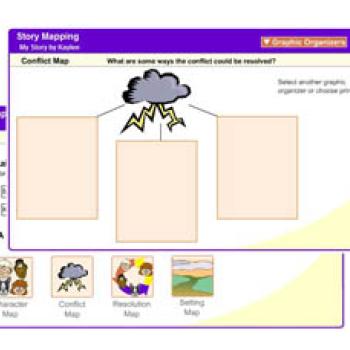
Grades K - 12
Student Interactive
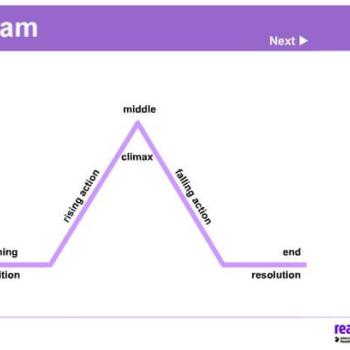
Grades 1 - 12
Plot Diagram
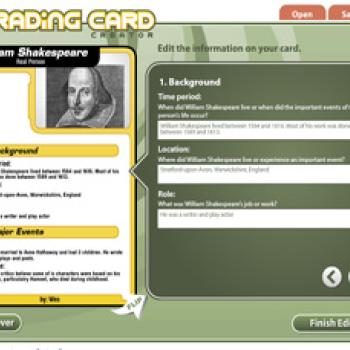
Grades 3 - 12
Trading Card Creator

Grades 6 - 12
Socratic Seminars
Strategy Guide

Grades 5 - 12
Introducing New Content with Seed Discussions
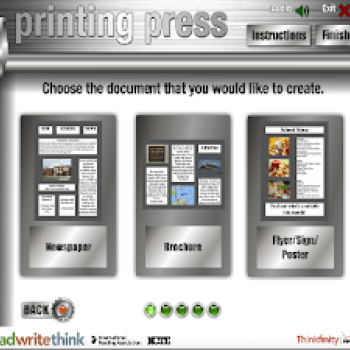
Printing Press

Diamante Poems
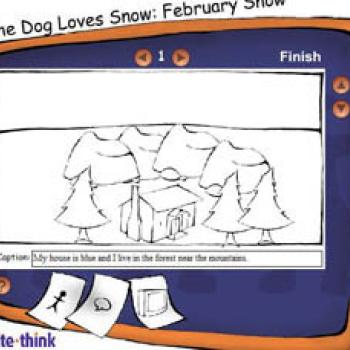
Comic Creator
Lesson plans.
We have hundreds of standards-based lesson plans written and reviewed by educators using current research and the best instructional practices. Find the perfect one for your grade band.

That's Not Fair! Examining Civil Liberties With the U.S. Supreme Court
In this lesson, high school students work in groups to explore the issue of civil liberties by conducting Internet research on related court cases

Engineering the Perfect Poem by Using the Vocabulary of STEM
Engineering is the “silent E” in STEM subject areas.

Finding Poetry in Prose: Reading and Writing Love Poems
When students think of love poetry, they almost invariably think of poetry about romantic love.

Many Years Later: Responding to Gwendolyn Brooks' "We Real Cool"
Students analyze the literary features of Gwendolyn Brooks' “We Real Cool” and then imagine themselves as one of the characters in the poem many ye
Student Interactives
Engage your students in online literacy learning with these interactive tools that help them accomplish a variety of goals—from organizing their thoughts to learning about language—all while having fun.
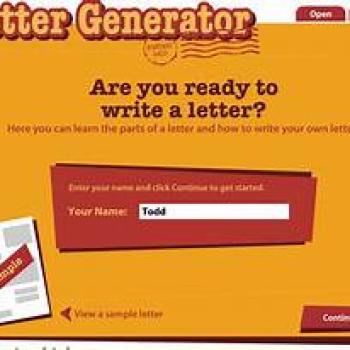
Letter Generator
The Letter Generator tool is designed to help students learn to identify all the essential parts of a business or friendly letter, and then generat
Grades K - 12 | Student Interactive
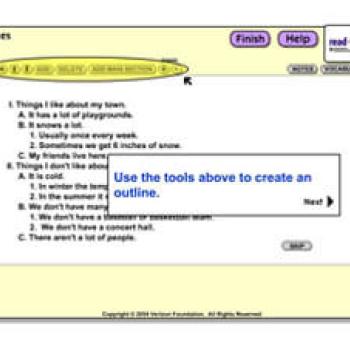
ReadWriteThink Notetaker
This hierarchical outlining tool allows students to organize up to five levels of information for reading and writing activities.
Grades 3 - 12 | Student Interactive
The Trading Card tool gives students an alternative way to demonstrate their literacy knowledge and skill when writing about popular culture texts
The interactive Printing Press is designed to assist students in creating newspapers, brochures, and flyers.
Professional Development
This strategy guide explains Socratic seminars and offers practical methods for applying the approach in your classroom to help s
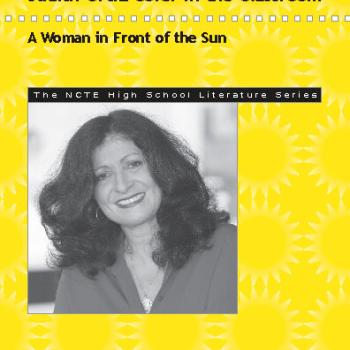
Judith Ortiz Cofer in the Classroom: A Woman in Front of the Sun
In an era of increasing emphasis on standardized testing, it can be difficult to add the works of new authors to the high school English curriculum
Explore Resources by Grade

IMAGES
VIDEO
COMMENTS
Cutting out lines is painful for them! Often, a lesson plan for creative writing involves providing time for meaningful writing. For two days, we study and discuss creative nonfiction. Students start by reading an overview of creative nonfiction. (If you need mentor texts, that website has some as well.)
The "I Remember" Poem. Students use personal experience to write creatively in this poetry lesson plan. They'll think back and choose a dozen…. Subjects: Reading and Literature. Poetry. Creative Writing. Download. Add to Favorites.
The cards are structured in a way to help your student generate gobs of ideas for a short story. Inspire your student to write with fairy tale settings, objects, and characters. Write spooky stories with this set of flip, mix, and match strips. Students are given various options for settings, characters, and conflicts.
First, please remember that any teacher can use these creative writing lessons. You don't need to be teaching homeschoolers. You can be a classroom teacher or a homeschool teacher at home with one student. You can even be a librarian who needs a fun program series. Second, I used these creative writing lesson plans with upper elementary ...
They learn to write for an audience. Reading their writing aloud strengthens their understanding of the written word. Enjoy the following links as you develop creative writing lesson plans for a variety of writing modes: narrative, persuasive, expository, and descriptive. May your classroom creative writing community sparkle and shine:
Overview. To promote development, detail, and focus of ideas in students' writing, it sometimes helps to start with a fun, creative writing activity that encourages what you want to see in all of their writing. In this minilesson, students practice writing detailed, sensory-rich descriptions by framing a small piece of nature and freewriting ...
Overview. Wordless picture books offer a wonderful foundation for creative writing. Often, students struggle with ideas and topics for writing. This genre of books offers a platform for students to develop their writing skills. In this lesson, students are exposed to wordless picture books and begin developing story lines orally and in writing.
digital literacy (45) Grammar (11) inquiry / research (151) listening (64) literary analysis (78) Media literacy (78) ... Lesson Plans We have hundreds of standards-based lesson plans written and reviewed by educators using current research and the best instructional practices. ... How-To Writing: Motivating Students to Write for a Real Purpose ...
Skill Builders: Word Analogy Questions, Week 28. Week 28: Word analogies to sharpen students' thinking skills and prepare them for standardized tests. Browse our printable 8th Grade Creative Writing Lesson Plans resources for your classroom. Download free today!
Browse creative writing lesson plans for teachers! Help your students construct short sentences, write acrostic poems, and create fun stories. Start for free! ... Reading Skills (101) Communication Skills (13) Writing (10) Creative Writing (9) Grammar (93) Adverbs and Adjectives (15)
1. Education.com offers creative writing lesson plans to kids of all ages. Teachers will find our lesson plans spark their classroom's imagination into artistic storytelling and writing. Our lesson plans are all purposefully themed so children can think outside the box when applying creative writing concepts. Don't delay the creativity - start now!
Creative State of Mind: Focusing on the Writing Process In this lesson, students examine the lyrics of rap artist Jay-Z for literary elements including rhyme, metaphor, puns and allusions, then consider what he says about his own writing process. Finally, they analyze additional lyrics and apply lessons from Jay-Z's process to their own reading ...
Ideas for a Creative Writing Course Plan Creative Writing Lesson Plans and Activities Primary/Elementary School ... A story map is a tool, often used in both reading and writing instruction, that helps students to understand the important elements of a story. Before beginning a story, have kids plan out story elements such as character,
Creative Writing Lesson Plans. April 15, 2020 / Writing. Creative writing is an important writing style for students to learn about and experience on their journey to becoming writers. Helping students embrace their creativity is a great way to get students writing. Students enjoy writing more when they get choice over their topic and format.
Creative Writing Lesson Plan Instructor Dana Dance-Schissel Show bio. ... CCSS.ELA-LITERACY.W.6.5 ; With some guidance and support from peers and adults, develop and strengthen writing as needed ...
Mysteries are a great way to hook students into writing about fictional happenings. In this lesson, students engage themselves in The Mysteries of Harris Burdick by examining the illustrations in the book and choosing one for which to create a Mystery Cube and then a creative writing piece.Finally, students present their mysteries to the class and allow students to guess to which illustration ...
Dive into a spooky-type short story and character analysiswith "The Most Dangerous Game.". "Most Dangerous Game" Character Analysis Workbookfrom Teach BeTween the Lines. MAKER SPACE. This creative lesson to inspire secondary writers is a newer approach. Turn your writer's workshop into a maker spacewith these unique ideas from Spark ...
10. Just Add Music. Music is my go-to when I need to add a little bit of pizzazz and creativity to an otherwise straight forward lesson plan. I use music with poetry, as a hook for a lesson plan on figurative language, as a paired text complement, and as an end-of-the-year reflection, among other things.
Exercise #1: Write a story or poem inspired by music. Jean-Michel Basquiat, pictured in 1981, painted and wrote poetry to Bach, Bowie and bebop. Related Article Edo Bertoglio, via Maripol/Artestar ...
Discover ideas and strategies that support literacy learning, specially curated for this grade band. ... Featured Resources, Grades 7-8. Grades 7 - 9. Lesson Plan Type: Unit. Finding Solutions to Food Waste: Persuasion in a Digital World Read More ... Wordless picture books offer a wonderful foundation for creative writing. Often, students ...
I have included all my plans, resources, success criteria etc. The lesson was judged as outstanding following my last observation. It focuses on varying sentence length for effect but also includes scope for other creative writing techniques. Read the main text through with the class before showing the film and keep the giraffes as a surprise!
Skill Builders: Word Analogy Questions, Week 29. Week 29: Word analogies to sharpen students' thinking skills and prepare them for standardized tests. Browse our printable 7th Grade Creative Writing Lesson Plans resources for your classroom. Download free today!
The Purdue On-Campus Writing Lab and Purdue Online Writing Lab assist clients in their development as writers—no matter what their skill level—with on-campus consultations, online participation, and community engagement. The Purdue Writing Lab serves the Purdue, West Lafayette, campus and coordinates with local literacy initiatives. The ...
We have hundreds of standards-based lesson plans written and reviewed by educators using current research and the best instructional practices. Find the perfect one for your grade band. ... This hierarchical outlining tool allows students to organize up to five levels of information for reading and writing activities. Read More . Grades 3 - 12 ...